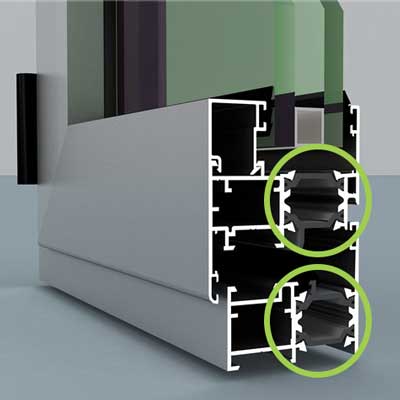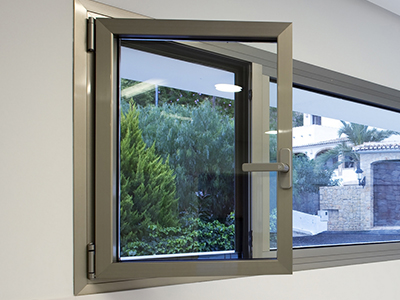Thermal Break Windows: A Complete Guide
Introduction
Thermally broken windows are a key innovation for improving the energy efficiency of any building. This type of window has become increasingly popular, especially in regions with cold winters and hot summers. In this article, we'll explore in detail what these windows are, their distinctive features, and how installing them can transform your home. Discover how these renovations can not only save you energy but also contribute to comfort and sustainability.
Defining Thermally Broken Windows
Thermally broken windows are designed with a clear purpose: to minimize heat transfer through the windows, thereby improving the building's energy efficiency. This approach is essential for locations where maintaining warmth in winter and coolness in summer is crucial. A prime example of the demand for this product is our experience with renovations in Madrid.
Thermal break refers to the deliberate interruption of heat transfer between the inside and outside of a window. In traditional windows without this break, the frame is made of a single material, such as aluminum or steel, which easily conducts heat. This can result in heat loss in winter and heat gain in summer, increasing the energy consumption needed to maintain a comfortable indoor temperature.
Key Features of Thermal Break Windows
Thermally broken windows have several features that make them stand out in terms of thermal insulation and energy efficiency. Some of these features include:
1. Double or Triple Glass Design
These windows typically incorporate a double- or triple-pane design. This arrangement creates an additional thermal insulation barrier between the interior and exterior of the window. The direct consequence is a significant reduction in heat transfer through the window, thus improving the building's energy efficiency.
2. Frame with Thermal Break
The window frame in these models is specially designed with additional thermal insulation. The introduction of insulating materials, such as polyamide or polyurethane, between two or more pieces of the metal window frame creates the necessary "break" to stop the flow of heat. This results in a significant reduction in heat loss in winter and heat gain in summer.
3. Hermetic Seal
Thermally broken windows typically feature a hermetic seal. This seal is crucial for preventing air and water leaks, helping to maintain a constant interior temperature and reducing energy loss.
4. Low Heat Transfer Coefficient Profiles
The profiles of these windows generally have a low thermal transmission coefficient. This means they are less conductive of heat, further improving energy efficiency by reducing heat transfer through the window frame.
5. Additional Accessories
These windows often offer the option of adding additional accessories, such as blinds, Venetian blinds, or solar control glass. These accessories not only improve energy efficiency but also provide additional control over light and heat entry.
Request your free quote with ReproBarcelona
Advantages of Choosing Thermal Break Windows
Installing thermally broken windows offers multiple advantages, improving energy efficiency, interior comfort, and sustainability. Some of the most notable benefits include:
1. Energy Saving
By significantly reducing heat transfer through the window, these windows retain heat in the winter and keep it out in the summer. This efficient thermal insulation can result in lower energy consumption for heating and air conditioning, leading to long-term energy savings and reduced costs.
2. Greater Interior Comfort
By minimizing heat transfer through the window, thermally broken windows help maintain a more constant and comfortable interior temperature throughout the year. This eliminates cold drafts in winter and reduces heat gain in summer, thus improving thermal comfort inside the building.
3. Condensation Reduction
These windows can also help reduce condensation on windows, as the thermal insulation they provide keeps the glass surfaces warmer. This prevents condensation from forming on the glass and window frame, contributing to a drier, healthier indoor environment.
4. Improved Sound Insulation
In addition to their impact on energy efficiency, thermally broken windows can improve a home's sound insulation. This helps reduce the penetration of outside noise, thus improving acoustic comfort inside the building.
5. Contribution to Sustainability
By reducing energy consumption and greenhouse gas emissions associated with heating and air conditioning, these windows contribute to building sustainability and reduce environmental impact. Furthermore, many of these windows use recyclable materials and are durable, further contributing to product lifecycle sustainability.
How to Identify if a Window Has a Thermal Break?
If you recently purchased a home and aren't sure if your windows have thermal breaks, here are some steps to help you identify them:
1. Observe the Window Profile
Thermally broken windows tend to have a profile composed of two or more pieces of aluminum or PVC separated by an insulating layer of plastic. This layer acts as a thermal barrier. If the profile clearly shows two or more pieces of material separated by a plastic layer, it likely has a thermal break.
2. Examine the Glass
These windows are typically double- or triple-paned, with an air or gas chamber between the layers to improve thermal insulation. They may also have a low-emissivity coating on one side to further improve energy efficiency. If you see double- or triple-paned glass with an air or gas chamber and possibly a low-emissivity coating, the window likely has a thermal break.
3. Consult with a Professional
If you still have doubts, it's a good idea to consult with a window professional, such as an installer. They can examine the window's features and provide you with an accurate assessment.
Cost of Thermally Broken Windows
The cost of these windows can vary depending on factors such as size, material, and specific features. Additionally, the location of purchase and geographic region also influence the price. For an accurate estimate, it is recommended to obtain personalized quotes that include both the cost of the windows and their installation.
Conclusion
Thermally broken windows represent a smart investment for those looking to improve their home's energy efficiency. Not only do they provide significant savings over time, but they also contribute to interior comfort and the building's sustainability. At ReproBarcelona, we are committed to offering cutting-edge renovation solutions that include the installation of thermally broken windows. Are you ready to transform your home? Calculate the price of your renovation with thermally broken windows in our detailed estimator!









